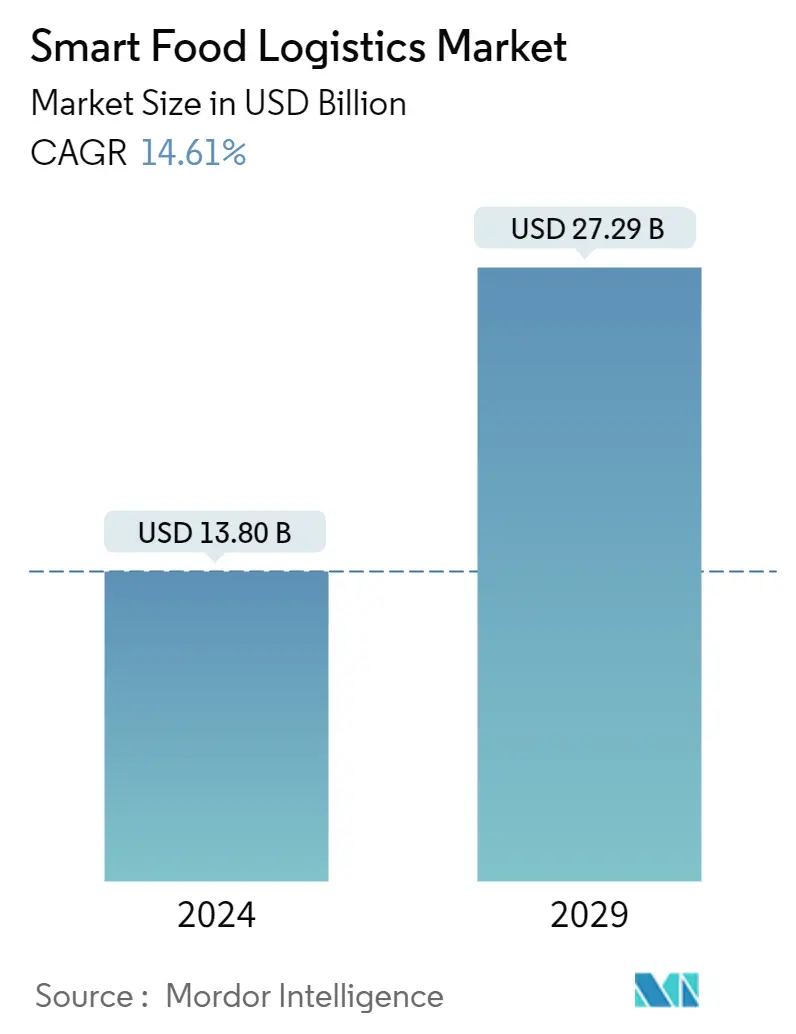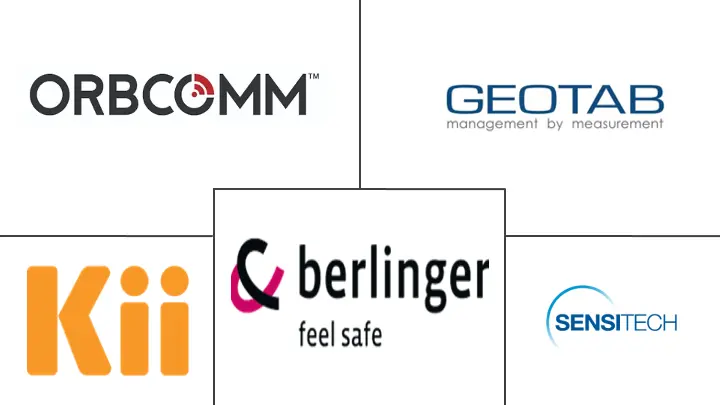Market Size of Smart Food Logistics Industry

| Study Period | 2019 - 2029 |
| Market Size (2024) | USD 13.80 Billion |
| Market Size (2029) | USD 27.29 Billion |
| CAGR (2024 - 2029) | 14.61 % |
| Fastest Growing Market | Asia-Pacific |
| Largest Market | North America |
Major Players
*Disclaimer: Major Players sorted in no particular order |
Smart Food Logistics Market Analysis
The Smart Food Logistics Market size is estimated at USD 13.80 billion in 2024, and is expected to reach USD 27.29 billion by 2029, growing at a CAGR of 14.61% during the forecast period (2024-2029).
There is a rising trend of utilizing cold chain monitoring technologies by smart food logistics companies, especially to assist food makers in managing the transport, storage, and distribution of temperature-controlled products. Temperature changes caused by traffic jams, mechanical problems, and other things can ruin and make unsafe food that hasn't been preserved, which is a big reason why the market is growing so quickly.
- As the digital economy expands, IoT technology has evolved from a futuristic idea to a practical tool for logistics companies to use in their supply chains. Sensors and IoT tools are changing traditional asset tracking toward intelligent supply chains that can generate a higher ROI for logistics firms. These IoT-enabled sensors provide real-time information on asset or fleet location, fleet mobility speed, temperature conditions, and other critical data sets for the food industry.
- Also, the tight integration of warehouse, transport, and end-consumer information and transparency through the supply chain has been made possible by logistics and technology, along with cloud-based collaborative solutions that extend through the entire supply chain. This, in turn, has been recognized as a key driver of the growth of the market under study. Also, different food laws and regulations in different areas, like the Food and Drug Safety Act, put a lot of pressure on supply chains to record more information and be more open, which is a big reason for the market's overall growth rate.
- Moreover, the market is witnessing various strategic mergers, acquisitions, and investments by key players as part of its strategy to improve business and their presence to reach customers and meet their requirements for various applications. For example, on August 20, 2022, the Regional Centre of Excellence against Hunger and Malnutrition (CERFAM) and HELP Logistics signed a Memorandum of Understanding. The main goal was to set up a new platform for collaboration in different areas of technical, scientific, and educational research. The activities of this platform would be aimed at strengthening agri-food value chains and the overall resilience of communities in Africa to socio-economic shocks.
- But different levels of complexity in the overall installation processes could slow the market's growth over the next few years.
- The COVID-19 pandemic significantly interrupted practically all end-user industries worldwide, disrupting company supply chain management owing to remote working circumstances or total lockdown, resulting in the halt of operations. In order to survive the pandemic and keep their operations running smoothly, the disruption caused companies to use technology and digitalization more. As a result, the market is expected to have many growth opportunities over the next few years.
Smart Food Logistics Industry Segmentation
The ability to get fresh food items while having real-time access to food motion is smart logistics enabled by the Internet of Things. The current market study examines major smart logistics solutions used to optimize food supply chains, such as fleet management solutions, asset tracking solutions, and cold chain monitoring solutions.
The smart food logistics market is segmented by component (hardware, software, and services), technology (fleet management, asset tracking, cold chain monitoring), and geography (North America, Europe, Asia-Pacific, Latin America, the Middle East, and Africa). The market sizes and forecasts are provided in terms of value (USD million) for all the above segments.
| Component | |
| Hardware (Sensors, Telematics, Networking Devices, etc.) | |
| Software and Services |
| Technology | |
| Fleet Management | |
| Asset Tracking | |
| Cold Chain Monitoring |
| Geography | |
| North America | |
| Europe | |
| Asia-Pacific | |
| Latin America | |
| Middle East and Africa |
Smart Food Logistics Market Size Summary
The smart food logistics market is experiencing significant growth, driven by the increasing adoption of cold chain monitoring technologies and IoT solutions. These advancements are crucial for managing the transport, storage, and distribution of temperature-sensitive food products, ensuring their safety and quality. The integration of sensors and IoT tools into supply chains is transforming traditional logistics into intelligent systems that offer real-time data on asset locations, temperature conditions, and other vital metrics. This shift is further supported by cloud-based collaborative solutions that enhance transparency and integration across the supply chain. Regulatory pressures and the need for greater transparency in food safety are also contributing to the market's expansion, as companies strive to meet stringent food laws and regulations.
The market is characterized by strategic mergers, acquisitions, and investments by key players aiming to enhance their market presence and meet diverse customer needs. The COVID-19 pandemic has accelerated the adoption of digital technologies in logistics, creating new growth opportunities. Automation and technology adoption in food and beverage logistics are driven by the demand for zero contamination, precise storage, and efficient retrieval operations. Regions like North America are leading in smart logistics adoption due to their strong manufacturing and transportation sectors, supported by government initiatives. The market's growth is further bolstered by significant investments in infrastructure and technology, aimed at strengthening the food supply chain and improving operational efficiency.
Smart Food Logistics Market Size - Table of Contents
-
1. MARKET INSIGHTS
-
1.1 Market Overview
-
1.2 Industry Value Chain Analysis
-
1.3 Industry Attractiveness - Porter's Five Forces Analysis
-
1.3.1 Threat of New Entrants
-
1.3.2 Bargaining Power of Buyers
-
1.3.3 Bargaining Power of Suppliers
-
1.3.4 Threat of Substitute Products
-
1.3.5 Intensity of Competitive Rivalry
-
-
-
2. MARKET SEGMENTATION
-
2.1 Component
-
2.1.1 Hardware (Sensors, Telematics, Networking Devices, etc.)
-
2.1.2 Software and Services
-
-
2.2 Technology
-
2.2.1 Fleet Management
-
2.2.2 Asset Tracking
-
2.2.3 Cold Chain Monitoring
-
-
2.3 Geography
-
2.3.1 North America
-
2.3.2 Europe
-
2.3.3 Asia-Pacific
-
2.3.4 Latin America
-
2.3.5 Middle East and Africa
-
-
Smart Food Logistics Market Size FAQs
How big is the Smart Food Logistics Market?
The Smart Food Logistics Market size is expected to reach USD 13.80 billion in 2024 and grow at a CAGR of 14.61% to reach USD 27.29 billion by 2029.
What is the current Smart Food Logistics Market size?
In 2024, the Smart Food Logistics Market size is expected to reach USD 13.80 billion.

